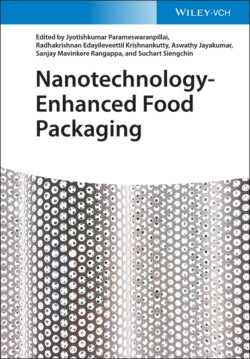Читать книгу Nanotechnology-Enhanced Food Packaging - Группа авторов - Страница 20
1.5 Nanocoating Applications in Food Industry
ОглавлениеFood coating can be described as a thin film of an edible composite material to prevent mass transfer. Such coatings can serve as barriers to moisture and gases. Coatings are added directly and formed by applying a fluid film-forming solution or liquid compounds on the food component. Edible surface materials may be classified into two categories: soluble polysaccharides and lipids. Alginates, cellulose, pectin, starch, chitosan, and other polysaccharides are suitable polysaccharides. Many lipid compounds have been used for producing culinary films and clothes such as animal or vegetable fats, waxes, acylglycerols, and fatty acids, which can act as an appropriate lipid. Lipid films have outstanding moisture trapping properties or as binding agents for gloss applying to chocolate. Waxes are widely used to cover fruit and vegetables to slow ventilation and to prevent moisture loss [46].
Edible coatings are used in a broad variety of products from nuts, herbs, poultry, sweets, cheese, candies, bakery, and fried food. Few research work has documented nanoparticles being incorporated into coating films to enhance their physical properties by enhancing the release of oxygen; montmorillonite clay was applied to pectins. Similarly, gelatin and montmorillonite-derived nanocomposites have been used to greatly change physical properties. There was also a considerable increase in chitosan/layered nanocomposites stability. Nanoparticles can be used as antimicrobial and additive carriers. It can also be used to stabilize additives and control their diffusion effectively in food and the various regions, e.g. surface vs. bulk of the food system. This control may be useful for long-term food storage or for conveying certain desired characteristics like flavor to a food system. In this way, the United States has also produced an edible antibacterial nanocoating that can be applied directly to baking products, released by the Sono-Tec Corporation [46–49].
The three main applications of nanomaterials in food packaging were also described as research trends in food packaging using nanotechnology, where nanoreinforcement, active nanocomposite packaging, and intelligent nanocomposite packaging are the main issues for food packaging. The presence of nanoparticles in the polymer matrix products increases the properties of the commodity in better packaging. In addition to barrier properties, strength, rigidity, dimensional stability, and material heat tolerance may be strengthened by inserting nanoclays or SiO2 nanoparticles. Nanoparticles are specially developed for applications of antimicrobial packaging in active packaging as active agents, silver, gold, and metal–oxygen nanoparticles with the antimicrobial function being the most studied nanoparticles with silver nanoparticles already present in several commercial applications. This is suitable for other fields of active packaging such as ethylene layer removers. Nanoparticles may be used as reactive particles in packaging materials for smart packaging to warn about the quality of the drug packed. To interact and to classify the drug, the so-called nanosensors can respond to external stimulation adjustments to ensure its consistency and health. Recent developments in polymer nanomaterials are oxygen indicators, freshness indicators, and pathogenic in smart food packaging.
